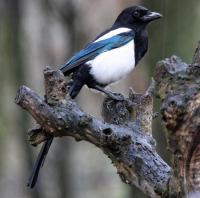- Home
- FAQs
- Customer Video Gallery
- Customer Photo Gallery
- Bird Facts
- Bird Food Blog
- Bird Information
- Feeding Advice
- Small Animal Information
- A to Z of Guinea Pigs
- A to Z of Hamsters
- A to Z of Rabbits
- Basic Care for Guinea Pigs
- Basic Care for Hamsters
- Basic Care for Rabbits
- Basic care for Chinchillas
- Basic care for Ferrets
- Basic care for Gerbils
- Basic care for Mice
- Basic care for Rats
- Buying a Healthy Small Animal
- Does your Reptile need a Licence
- Equipment for Ferrets
- Equipment for Hamsters
- Equipment for Mice
- Equipment for your Chinchilla
- Equipment for your Gerbil
- Equipment for your Guinea Pig
- Equipment for your Rabbit
- Keeping a House Rabbit
- Dog Information
- Cat Information
- Customer Information
- Fat Balls
- Suet Pellets
- Straights
- Seed Mixes
- Suet Treats
- Mealworms
- Bird Feeders
- My Account

| Scientific Name | Pica pica |
| Breeding | early April |
| Fledge Days | 26-31 |
| Incubation Days | 20 |
| Lifespan | 5 years |
| Number of Clutches | 1 |
| Number of Eggs | 5-6 |
| Size | 44-46cm |
| Weight | 200-240 |
| Wingspan | 56cm |
Bird Family : Crows and Allies
Magpie Facts - Information About Magpie
Magpie - Pica Pica
The Magpie is the most easily identifiable member of the Corvid (Crow) family, its black and white colouration, long tail, large size and rattling call makes it obvious. The rhyme ‘One for sorrow, two for joy etc.’ is quite apt for this species as you very rarely see a single bird, usually they parade around in a small family groups.
Identification:
Adults
- Without doubt another of UKs most easily recognised birds.
- Adult males and females are alike.
- Magpies are large birds, around 45-50cm in length and a wing span of 55cm.
- They often appear in small groups foraging noisily for food.
- The birds plumage appears to be black and white but on closer inspection the blacks have a beautiful iridescent sheen of greens, blues and purples.
- Upper parts; head, breast are black with very little sheen whilst the wings show an iridescent blue gloss, the long black tail also has an iridescent sheen, but this time bottle green.
- Undertail coverts are matt black.
- At rest bird shows a large white scapular patch just above the wing.
- Belly, flanks and rump are white.
- In flight the white primaries (outer wing) are obvious.
- Bill, legs and eye black.
Juveniles
- Juveniles appear from May onwards and look similar to adults; the only real difference is in the length of the tail, which is much shorter, about half the length of an adult.
Status and Distribution
The Magpie is a very abundant breeding resident in the UK with over 550,000 pairs. In addition to this there is a large non breeding population. The Magpie occurs in all counties throughout England, Wales and Ireland.
Magpies are far less common in Scotland as they are absent from the Highlands.
Habitat / Food
Magpies occur in all habitat types throughout the UK, towns, cities, woodlands, parks, gardens, farmland, hedgerows indeed any open country habitat, they are more local in Scotland as they absent in the Highlands.
Magpies will forage for food and will raid nests for eggs and chicks.Their diet includes Insects, carrion, scraps, Seed Mixes, Fruit and Fat Balls . Magpies are not fussy eaters and will have a go at almost anything!
Song / Call
The hard loud metallic rattles and chatters are commonly heard as a troop of Magpies move through. These sound similar to a football rattle.
The following food is favoured by Magpie


















